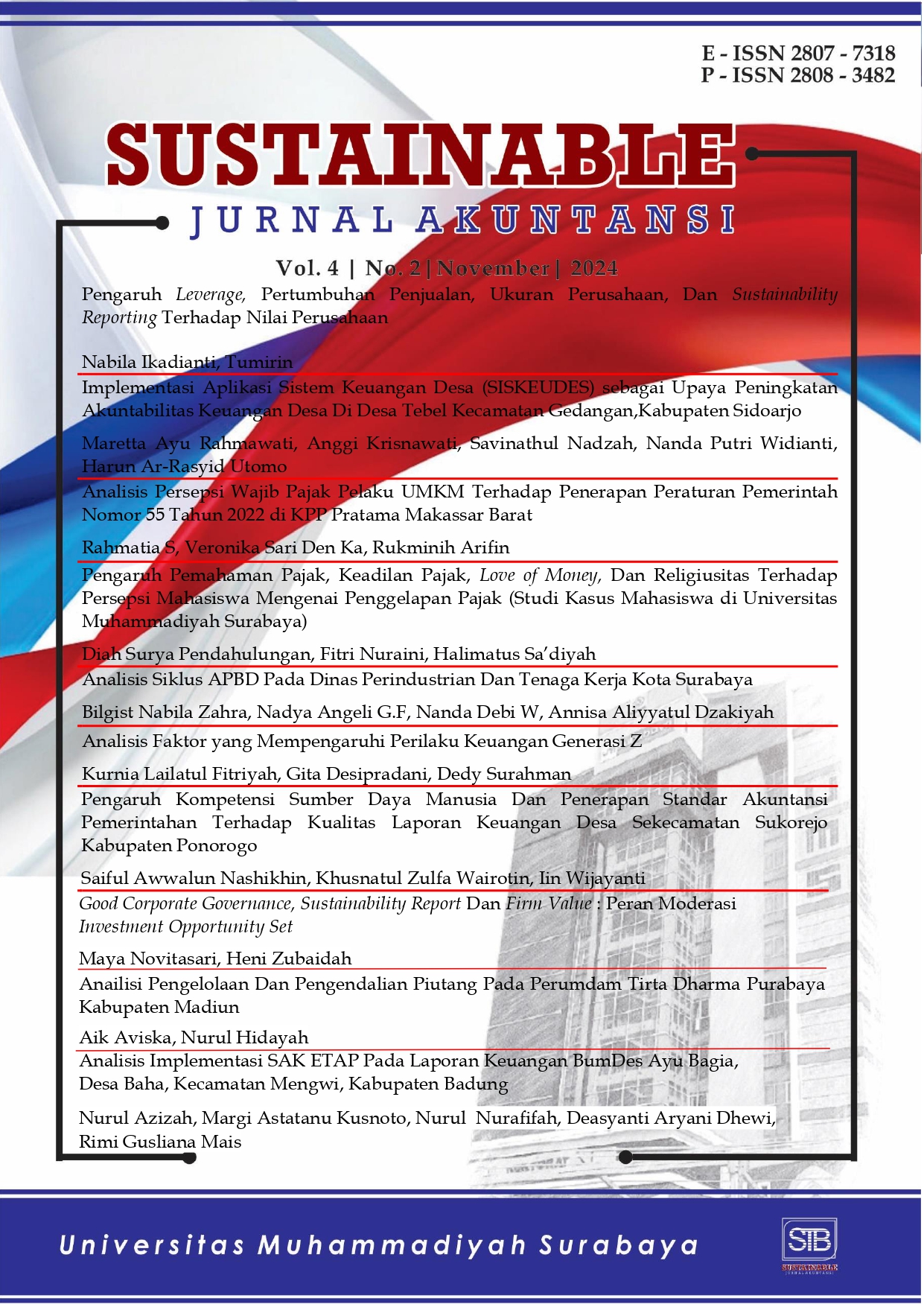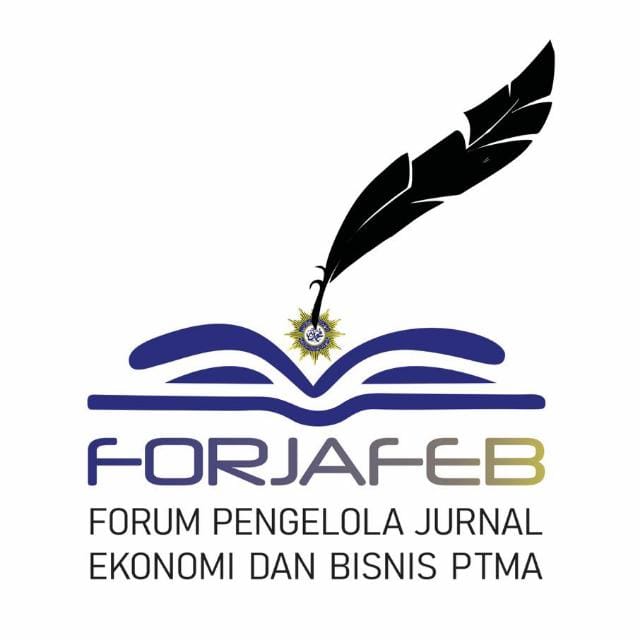Analisis Anteseden Financial Behavior Pada Mahasiswa Gen Z Prodi Akuntansi Universitas Muhammadiyah Surabaya
DOI:
https://doi.org/10.30651/stb.v4i2.24599Kata Kunci:
Literasi Keuangan, Financial Technology,, Financial BehaviorAbstrak
Penelitian ini dilakukan adanya fenomena pada masyarakat generasi muda di Indonesia perihal perilaku dan literasi keuangan yang kurang baik serta munculnya layanan produk dan jasa keuangan berbasis teknologi. Tujuan penelitian ini adalah untuk mengetahui pengaruh Literasi Keuangan (X1) dan Financial Technology (X2) terhadap Financial Behavior (Y) pada Mahasiswa Gen Z Prodi Akuntansi Universitas Muhammadiyah Surabaya. Pendekatan penelitian yang digunakan dalam penelitian ini adalah pendekatan kuantitatif dengan menggunakan kuesioner dalam pengumpulan data. Populasi dalam penelitian ini adalah Mahasiswa aktif Prodi Akuntansi tahun ajaran 2019-2022 Universitas Muhammadiyah Surabaya. Jumlah sampel adalah 60 responden. Data-data yang diolah menggunakan program IBM Statistics SPSS 25, berdasarkan hasil uji t yang dilakukan dapat diketahui bahwa literasi keuangan (X1) berpengaruh positif
positif dan signifikan terhadap financial behavior (Y) dan financial technology (X2) tidak berpengaruh signifikan terhadap financial behavior (Y). Berdasarkan hasil uji F yang dilakukan, dapat diketahui bahwa Literasi Keuangan (X1) dan Financial Technology (X2) secara simultan berpengaruh positif dan signifikan terhadap variabel financial behavior (Y) pada Mahasiswa Gen Z Prodi Akuntansi Universitas Muhammadiyah Surabaya.
Referensi
Ajzen, Icek & Fishbein. (1980). Theory of Reasoned Action. Edisi Kesatu. Oleh Jogiyanto.
Yogyakarta: Andi Publisher.
Ajzen, I. 1991. The Theory of Planned Behavior. Organizational Behavior and Human Decision Processes, 50: 179-211.
Akben-selcuk, E. (2015). Factors Influencing College Students ’ Financial Behaviors in Turkey : Evidence from a National Survey. 7(6), 87–94. https://doi.org/10.5539/ijef.v7n6p87
American Psychiatric Association. (2013). Diagnostic and Statistical Manual of Mental Disorder Edition (DSM-V). Washington: American Psychiatric Publishing.
Arikunto, S. (2016). Prosedur Penelitian Suatu Pendekatan Praktik. Jakarta: Rineka Cipta.
Baiq Fitri Arianti. (2021). LITERASI KEUANGAN (TEORI DAN IMPLEMENTASINYA). CV. Pena Persada.
Bank Indonesia. 2017. Peraturan Bank Indonesia Nomor 19/12/PBI/2017 tentang Penyelenggaraan Teknologi Finansial
Bayar, M. Y., Sezgin, H. F., Öztürk, Ö. F., & Şaşmaz, M. Ü. (2017). Impact of financial literacy on
personal savings: A research on Usak University staff.
Chen, H., & Volpe, R. p. (1998). An analysis of personal financial lieracy among college students. financial service review 7(2):107-128, 6
Conner, M. (2020). Theory of Planned Behavior. In Handbook of Sport Psychology (pp. 1–18). Wiley.
https://doi.org/10.1002/9781119568124.ch1 Dantes, N. (2012). Metode Penelitian. Yogyakarta: ANDI.
David LEE Kuo Chuen, dan Linda LOW, (2018), “Inclusive FinTech (Blockchain, Cryptocurrency,ans ICO)”, New York: Worid Scientific, 2018:1
Dr. Ratna Candra Sari, M. S. C. A. (2021). AKUNTANSI KEPERILAKUAN: Teori dan Implikasi.
Penerbit Andi. https://books.google.co.id/books?id=z34SEAAAQBAJ
Fishbein, M, & Ajzen, I. (1975). Belief, Attitude, Intention, and Behavior: An Introduction to Theory and Research, Reading. MA: Addison-Wesley.
Ghozali, I. (2011). “Aplikasi Analisis Multivariate Dengan Program SPSS.” Semarang: Badan Penerbit Universitas Diponegoro.
Ghozali, I. (2018). ”Aplikasi Analisis Multivariate dengan IBM SPSS 25”. Semarang: Badan Penerbit Universitas Diponegoro.
Gomber, P., Koch, J. A., & Siering, M. (2017). Digital Finance and FinTech: current research and future research directions. Journal of Business Economics, 87(5), 537–580. https://doi.org/10.1007/s11573- 017-0852-x
Grohmann, Antonia, et al. (2015). Childhood Roots of Financial literacy. Discussion Paper. Deutsches Institut für Wirtschaftsforschung. Deutsches Institut Für Wirtschaftsforschung. Http://Www.Diw.de/Documents/Publikatio.
Gunawan, C. (2019). Mahir Menguasai SPSS (Mudah Mengelola Data dengan IBM SPS Statistic 25). Yogyakarta: Deepublish.
Gutter, M. S., & Copur, Z. (2011). Financial Behaviors and Financial Well-Being of College Students : Evidence from a National Survey. Journal of Family and Economic Issues, 32, 699– 714. Https://Doi.Org/10.1007/S10834-011- 9255-2.
Hadari, N. (2012). Metode Penelitian Bidang Sosial. Yogyakarta: Gajah Mada University Press.
Halim, Y., & Astuti, D. (2015). Financial Stressors, Financial Behavior, Risk Tolerance, Financial Solvency. Finesta, 3(1), 19-23.
Herawati, N. T. (2015). Kontribusi pembelajaran di perguruan tinggi dan literasi keuangan terhadap perilaku keuangan mahasiswa. Jurnal Pendidikan Dan Pengajaran, 1–3(48), 60–70. https://doi.org/https://dx.doi.org/10.23887/jppundiksha.v48i1-3.6919
Hung, J.-L., & Luo, B. (2016). FinTech in Taiwan: a case study of a Bank’s strategic planning for an investment in a FinTech company. Financial Innovation, 2(1), 1–16.
Kholilah, N. Al, & Iramani, R. (2013). STUDI FINANCIAL MANAGEMENT BEHAVIOR PADA MASYARAKAT SURABAYA. 3(1), 69–80.
Kim, Y. H., Choi, J., Park, Y., & Yeon, J. (2016). the Adoption of Mobile Payment Services for “fintech.” International Journal of Applied
Lee, Y. (2021). Impacts of Digital Technostress and Digital Technology Self-Efficacy on Fintech Usage Intention of Chinese Gen Z Consumers.
Malinda, M. (2007). Perencanaan Keuangan Pribadi. Yogyakarta: Andi.
Maulida, R. (2019). Fintech: Pengertian, Jenis, Hingga Regulasinya di Indonesia. Retrieved from https://www.online-pajak.com/tentang-pajak-pribadi/fintech
Mubarokah, S., & Rita, M. R. (2020). Anteseden Perilaku Konsumtif Generasi Milenial: Peran Gender Sebagai Pemoderasi. International Journal of Social Science and Business, 4(2), 211–220. https://doi.org/10.23887/ijssb.v4i2.24139
Mukti, V. W., Rinofah, R., & Kusumawardhani, R. (2022). Volume . 19 Issue 1 ( 2022 ) Pages 52-58 AKUNTABEL : Jurnal Akuntansi dan Keuangan ISSN : 0216-7743 ( Print ) 2528-1135 ( Online ) Pengaruh fintech payment dan literasi keuangan terhadap perilaku manajemen keuangan mahasiswa The influence of fintech payme. 1(1), 52–58. https://doi.org/10.29264/jakt.v19i1.10389
Nababan, D., & Sadalia, I. (2012). Analisis personal financial liteacy dan financial behavior mahasiswa strata1 fakultas ekonomi universitas sumatera utara (personal financial liteacy analysis and the financial behavior of undergraduate students of the University of North Sumatra‟s econom. Media Informasi Manajemen, 1, 1–16.
Narastri, M., & Kafabih, A. (2020). FINANCIAL TECHNOLOGY (FINTECH) DI INDONESIA DITINJAU DARI PERSPEKTIF ISLAM. 2(2), 155–170.
National Digital Research Centre. (2014). "So what is FinTech”. https://www.ndrc.ie/. Diakses pada 12 Maret 2023.
OECD. (2016). PISA 2015 Assessment and Analytical Framework: Science, Reading, Mathematic and Financial Literacy. Paris: PISA.OECD Publishing.
Otoritas jasa keuangan. (2013). Strategi Nasional Literasi Keuangan Indonesia. 8 Oktober 2017. www.ojk.go.id
Otoritas Jasa Keuangan Republik Indonesia. (2016). Peraturan Otoritas Jasa Keuangan Nomor 77/POJK.07/2016 Tentang Layanan Pinjam Meminjam Uang Berbasis Teknologi Informasi.
Otoritas Jasa Keuangan. (2016). Survei Nasional Literasi dan Inklusi Keuangan 2016. Retrieved from www.ojk.go.id
Pambudi, R. D. (2019). Perkembangan fintech di kalangan mahasiswa uin walisongo. 4(2), 74–81.
Putri, N. M. D. R. dan Henny, R. (2017). Pengaruh Tingkat Literasi keuangan dan Faktor Sosiodemografi terhadap Perilaku Keputusan Investasi Individu. E- Jurnal Ekonomi Dan Bisnis Universitas Udayana, Vol 6. No.
Pulungan, D.R., Febriaty, H. “Pengaruh Gaya Hidup dan Literasi Keuangan terhadap Perilaku Konsumtif Mahasiswa”, Jurnal Riset Sains Manajemen, Vol. 2 No. 3 (2018) : 105-106. 10 Oktober, 2019 – 10.5281/zenodo.1410873.
Remund, David L. (2010). Financial Literacy Explicated: The Case for a Clearer Definition in an Increasingly Complex Economy. The Journal of Consumer Affairs, 44 (2), 276-295. Diunduh pada tanggal 25/06/23.
Ramadhani, N., & Ovami, D. C. (2021). Financial Technology dan Perilaku Keuangan Generasi Milenial. 13(1), 13–16.
Ricciardi, V. & Simon, H. K. (2000). What is Behavioral Finance? Business, Education and Technology Journal Fall 2000.
Siqueira, M. S. S., Nascimento, P. O., & Freire, A. P. (2022). Reporting Behaviour of People with Disabilities in relation to the Lack of Accessibility on Government Websites: Analysis in the light of the Theory of Planned Behaviour. Disability, CBR and Inclusive Development, 33(1), 52–68. https://doi.org/10.47985/dcidj.475
Sudaryo, Y. (2020). DIGITAL MARKETING DAN FINTECH DI INDONESIA. Yogyakarta: ANDI.
Sugiyono. (2014). Metode Penelitian Pendidikan Pendekatan Kuantitatif, Kualitatif, dan R&D. Bandung: ALFABETA.
Sugiyono. (2016). Metode Penelitian Kuantitatif, Kualitatif dan R&D. Bandung: PT Alfabet.
Sugiyono. (2017). Metode Penelitian Kuantitatif, Kualitatif, dan R&D. Bandung : Alfabeta, CV. Sugiyono. (2018). Metode Penelitian Kuantitatif. Bandung: Alfabeta.
Sugiyono. (2019). Metodelogi Penelitian Kuantitatif dan Kualitatif Dan R&D. Bandung: ALFABETA.
Sumiarni, L. (2019). Perilaku Self-Control dalam Mengelola Keuangan Pribadi ( Berdasarkan Theory Of Planned Behavior dan Conscientiousness ) di STIKes Merangin. 3(September), 105–112. https://doi.org/10.33087/ekonomis.v3i2.69
Supramono, Nastiti, P. K. Y., & Damayanti, T. W. (2018). Keuangan Berbasis Perilaku (I). Yogyakarta: Andi Offset.
Sutrisno, H. (1991). Metodologi Research Jilid 3. Yogyakarta: Andi Offset.
Woodyard, Ann., Robb, C. (2011). Financial Knowledge and Best Practice Behavior. Journal of Financial Counseling and Planning, Vol. 22, I.
Unduhan
Diterbitkan
Terbitan
Bagian
Lisensi
Hak Cipta (c) 2024 SUSTAINABLE JURNAL AKUNTANSI

Artikel ini berlisensi Creative Commons Attribution 4.0 International License.
Hak Cipta
Hak cipta terhadap artikel yang diterbitkan di Sustainable : Jurnal Akuntansi.
Penulis harus menyerahkan hak cipta pada jurnal dengan menandatangai dan mengirimkan form penyerahan hak cipta (template) melalui email sustainable@um-surabaya.ac.id
Penulis dapat menyebarluaskan artikelnya melalui media manapun.
Lisensi
Setiap karya yang ditulis penulis dilisensi dengan Creative Commons Attribution-NonCommercial 4.0 International License.

















